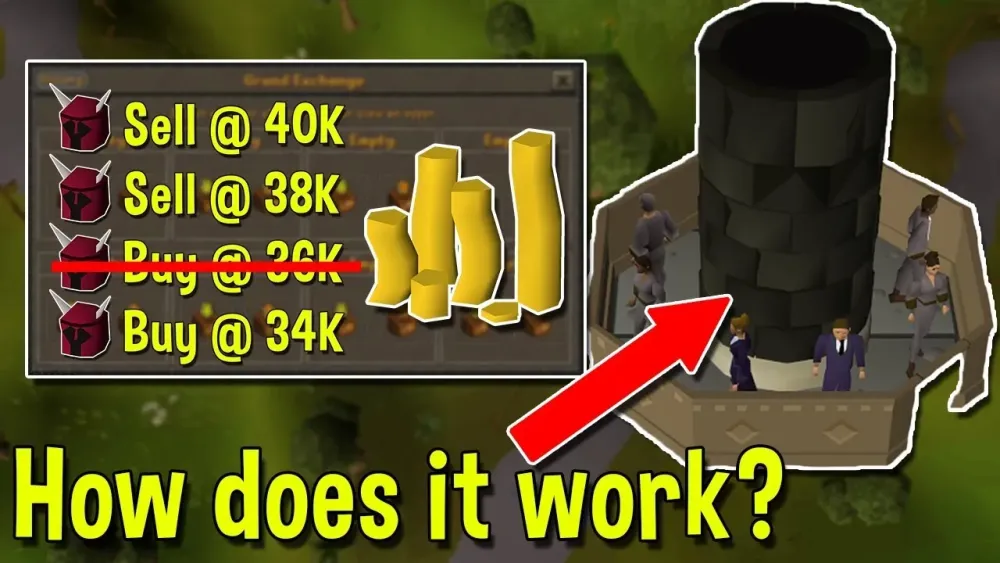Your cart is empty
Understanding Grand Exchange Prices in OSRS

The Grand Exchange is a crucial component of Old School RuneScape (OSRS), serving as the primary marketplace where players can buy and sell items. This system streamlines trading, making it easier for players to acquire goods without relying on direct player-to-player interaction. Understanding how the Grand Exchange operates, particularly how prices fluctuate, is essential for players looking to maximize their profits and manage their in-game economy effectively. This article delves into the intricacies of the Grand Exchange, focusing on the factors that influence item pricing.
Grand Exchange prices in OSRS are influenced by several key factors that reflect player behavior and market dynamics. The primary determinant is supply and demand; when an item is in high demand but low supply, its price tends to rise. Conversely, if an item is readily available but few players want it, its price will drop. Players can monitor these trends by observing price changes over time, particularly after updates or events that may affect item desirability.
Another factor is the historical price data. The Grand Exchange maintains records of prices for each item, which players can access to identify trends and make informed buying or selling decisions. Prices are typically averaged over a period, allowing players to gauge the market’s stability. However, sudden spikes or drops can occur due to player activity, such as large bulk purchases or sales intended to manipulate the market.
Seasonal events and updates can also have a significant impact. For example, new quests, items, or game mechanics can create a surge in demand for specific items, leading to temporary price increases. Additionally, items that are associated with popular in-game activities, such as skilling or bossing, may see fluctuating prices based on player engagement in those activities.
Lastly, player speculation plays a role in price determination. Some players may buy items anticipating future demand, thereby artificially inflating prices. This behavior can create a cycle where prices continue to rise until a correction occurs, often when the speculative bubble bursts as players start to sell off their holdings.
To summarize, understanding Grand Exchange prices involves analyzing supply and demand trends, historical pricing data, seasonal influences, and player speculation. By keeping an eye on these factors, players can make smarter trading decisions and navigate the OSRS economy more effectively.
Factors Affecting OSRS Item Prices
Understanding the Grand Exchange prices in Old School RuneScape (OSRS) is crucial for any player looking to maximize their gold. Several factors contribute to the fluctuation of item prices in the game. Here’s a breakdown of key elements that affect these prices:
- Supply and Demand: The fundamental economic principle of supply and demand plays a significant role. If an item is scarce (low supply) but highly sought after (high demand), its price will rise. Conversely, if there are too many of an item available, prices tend to drop.
- Updates and Events: Jagex frequently updates the game and introduces events that can influence item prices. For instance, new quests might increase the demand for certain items. Keeping an eye on updates can give you insight into potential price changes.
- Player Activity: The number of players online and their activity can affect prices. For example, during peak gaming hours, more players are buying and selling, which can lead to volatile prices.
- Item Rarity: Rare items or those with limited availability typically command higher prices. For instance, items that drop from bosses or are rewards from difficult quests are often more valuable.
- Market Trends: Just like in real-world markets, trends can affect prices. Following popular streamers or YouTubers can sometimes create hype around certain items, driving prices up.
By keeping these factors in mind, you can better understand why prices fluctuate and make more informed decisions when trading on the Grand Exchange.
How to Use the Grand Exchange for Profit
Using the Grand Exchange effectively can lead to significant profits in OSRS. Here are some strategies to help you get the most out of your trades:
- Research Prices: Before buying or selling, always check the current market price of an item. Use websites or in-game tools that track price trends to assess how much you should pay or charge.
- Buy Low, Sell High: This classic investment strategy applies here too! Look for items that are currently undervalued. Purchase them and wait for prices to rise before selling.
- Utilize Flipping: Flipping involves buying items at a lower price and selling them at a higher price. Focus on items that have a decent margin between buy and sell prices. Some players consistently flip items like potions, ores, or logs.
- Stay Updated: Keep yourself informed about game updates, events, and community trends. Changes can significantly impact item prices, so being proactive can lead to profitable opportunities.
- Timing is Key: Certain items sell better at specific times, like weekends or during events. Monitor the market and try to sell when demand is high.
By implementing these strategies, you can enhance your experience with the Grand Exchange and build your wealth in OSRS. Happy trading!
Popular Items and Their Price Trends
When diving into the world of Old School RuneScape (OSRS), understanding the Grand Exchange prices of popular items can significantly enhance your gaming experience. Some items consistently attract attention and trade, making their price trends crucial for players looking to maximize their profits.
Here’s a look at some popular items and their general price trends:
- Dragon Scimitar: This weapon is a player favorite due to its high attack speed and damage. Prices tend to fluctuate based on updates and player demand, usually ranging from 100,000 to 250,000 GP.
- Party Hats: A classic item that holds nostalgic value. Their prices can skyrocket, often reaching millions of GP, especially around in-game events or updates that revitalize interest.
- God Wars Dungeon Items: Gear such as the Armadyl Crossbow or Saradomin Sword sees price spikes during raids or boss events. These items can fluctuate from 500,000 GP to over 2 million GP based on availability and demand.
- Potion Supplies: Items like Super Restore Potions and Saradomin Brews are always in demand for PVM. Their prices usually stabilize around 1,000 to 5,000 GP each but can spike during major in-game events.
Tracking these items regularly can help players make informed decisions on when to buy or sell, capitalizing on the ever-changing market dynamics.
Tips for Monitoring Price Changes
Keeping an eye on price changes in the Grand Exchange is essential for any OSRS player looking to make the most of their investments. Here are some effective tips to help you stay updated:
- Use Price Tracking Websites: Several websites track Grand Exchange prices in real-time. Sites like OSBuddy or GE Tracker provide historical data and price trends, making it easier to spot potential buying or selling opportunities.
- Set Up Alerts: Many price tracking tools allow you to set alerts for specific items. Whenever an item hits your desired price, you’ll receive a notification, ensuring you never miss a deal.
- Join Community Forums: Engaging with the OSRS community on platforms like Reddit or Discord can provide valuable insights into market trends. Players often discuss their experiences and predictions, which can inform your trading strategies.
- Keep an Eye on Updates: Game updates can drastically affect item prices. Following OSRS news, patch notes, and even developer blogs can give you an idea of what items might become more or less valuable.
By employing these strategies, you can effectively monitor price changes and make informed decisions that enhance your OSRS gaming experience.
Understanding Market Fluctuations
In Old School RuneScape (OSRS), the Grand Exchange is a bustling marketplace where players buy and sell items. However, prices can fluctuate significantly due to various factors. Understanding these market fluctuations is essential for maximizing your trading profits.
Market fluctuations can be influenced by:
- Player Demand: When a new update or a popular event occurs, demand for certain items can skyrocket. For instance, if a new boss is released, players will rush to purchase gear that’s effective against it.
- Supply Changes: If an item becomes easier to obtain, its price may drop. Conversely, if a rare item is introduced or its drop rate is reduced, expect its price to rise.
- Seasonal Events: Holiday events can also impact prices. During events like Halloween or Christmas, certain items may see increased demand, causing their prices to fluctuate.
- Market Trends: Keeping an eye on long-term trends can help you predict future price movements. Some items might be stable, while others can be volatile.
To stay ahead in the Grand Exchange, consider using price tracking tools or websites that monitor item prices in real-time. This data can help you identify buying and selling opportunities. Additionally, participating in community discussions or forums can provide insights into market sentiment and upcoming trends.
Conclusion: Making the Most of the Grand Exchange
The Grand Exchange is a vital component of OSRS, offering players countless opportunities to trade and profit. By understanding how to navigate this marketplace, you can enhance your gaming experience and wealth.
Here are some tips to make the most of your Grand Exchange experience:
- Research Prices: Always check current prices before buying or selling an item. Use reliable sources to gauge what items are worth.
- Buy Low, Sell High: Look for items that are undervalued or overvalued. Patience is key; sometimes holding onto an item for a while can lead to better profits.
- Diversify Your Portfolio: Don’t put all your eggs in one basket. Invest in a variety of items to mitigate risks.
- Stay Informed: Keep an eye on game updates and community news. Changes can create new trading opportunities.
In summary, mastering the Grand Exchange requires a mix of research, strategy, and a bit of intuition. By understanding market fluctuations and applying smart trading practices, you can thrive in the world of OSRS.
